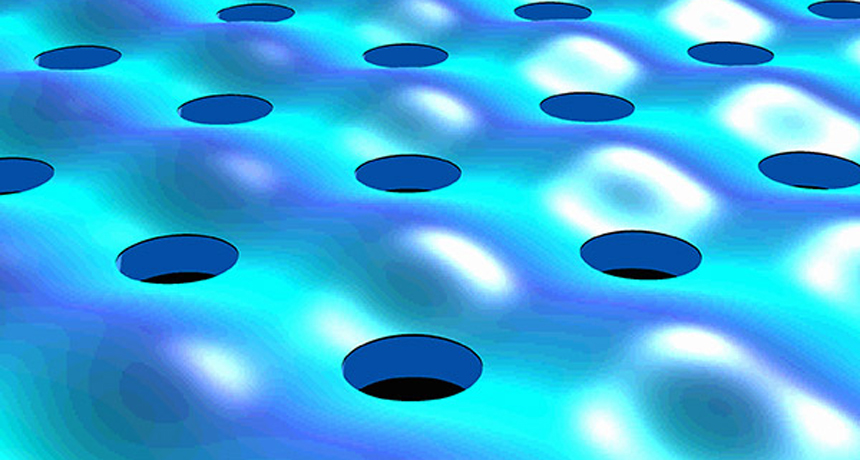Perfect reflections
Physicists design a new mirror to reflect light

A photonic crystal like the one illustrated here can be used as a perfect mirror.
Bo Zhen
Physicists have built a mirror that Snow White’s wicked stepmother would certainly not appreciate. It offers a perfect reflection.
The mirrors in our homes usually have a thin layer of metal sealed beneath a layer of glass. Light travels through the glass, reflects off of the metal and bounces back through the glass. But the mirror absorbs some light. So not all of the light completes the whole trip.
Scientists would prefer a more perfect mirror because light is crucial to many modern technologies. Devices like DVD players and optical fibers send and receive information using intense beams of light called lasers. A truly perfect mirror would make those lasers far more efficient.
The perfect reflector is nothing like the wall mirror we’re used to. Instead, it looks more like a tiny ceramic slab punched through with a grid of tiny holes. Those holes are so small that they can guide — or redirect — waves of light. This type of reflecting device is called a photonic crystal. (Photonic refers to photons, the particles that carry light. A crystal tends to have a symmetrical and orderly three-dimensional structure.)
Chia Wei Hsu, a physicist at the Massachusetts Institute of Technology in Cambridge, worked on the new photonic crystal. His team developed it and then shone light on it from various angles. They also beamed different colors of light onto it. Most times, the reflections did not return all of the light. Some entered the tiny holes and became absorbed by the slab.
But after many trials and errors, the researchers found one color and angle where the light was reflected perfectly. None was absorbed. In the July 11 issue of Nature, the scientists now explain how their crystal did this. It was something of a microscopic coincidence. Light waves trying to enter the holes collided with each other. During this collision of light, they essentially erased each other. This meant they couldn’t be absorbed by the slab. But they could be — and were — fully reflected.
An object with perfect mirrors on the inside, made from photonic crystals, would keep light trapped inside. That trapped light could be used to transmit information more efficiently.
Scientists have been discussing this approach to reflecting light for more than 80 years. Until now, “no one had thought of a practical method to do this,” notes Douglas Stone of Yale University in New Haven, Conn.
Power Words
crystal A solid consisting of a symmetrical, ordered, three-dimensional arrangement of atoms or molecules.
photonic crystal A synthetic crystal that can manipulate or respond to specific wavelengths of light.
laser A device that generates an intense beam of coherent light of a single color. Lasers are used in drilling and cutting, alignment and guidance, and in surgery.
physics The scientific study of the nature and properties of matter and energy.







